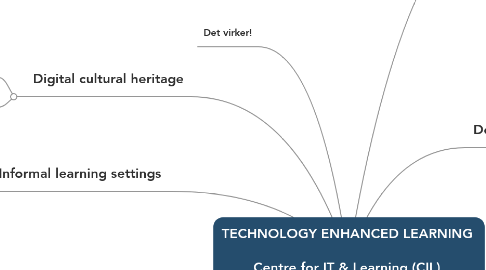
1. Digital cultural heritage
1.1. Beyond institutional borders
1.2. Beyond physical exhibitions
2. Informal learning settings
2.1. Institutions can make knowledge available to a wider public
2.2. Institutions can move beyond the borders of classes and courses
3. Educational resources
3.1. Collections of resources
3.2. Resources that can be used for a variety of purposes
3.3. Open Educational Resources
4. M-learning
4.1. Personalised learning
4.2. Relations between formal and informal learning settings
4.3. Just-in-time/just-in-place (location-based services)
5. Det virker!
6. CIL research profile
6.1. Research objective
6.1.1. The main research question of CIL is how digital media and web-based communication forums can support learning in formal and informal contexts, and how learning activities and learning environments are designed.
6.2. People
6.2.1. Helle Mathiasen, Professor
6.2.2. Jørgen Bang, Associate professor
6.2.3. Arne Kjær, Vice Dean, Associate professor
6.2.4. Elsebeth Korsgaard Sorense, Associate professor
6.2.5. Christian Dalsgaard, Postdoctoral researcher
6.2.6. Christian Winther Bech, Research Assistant
6.2.7. Klaus Thestrup, PhD Candidate
6.3. Student-centred pedagogical approach
6.3.1. Self-governed activities of students
6.3.2. Communication and collaboration
6.3.3. Student engagement and empowerment
6.3.4. From knowledge transmission to learning activities
6.3.5. From transfer to dialogue
6.4. Research questions
6.4.1. How can net-mediated communication forums enable learning and how can these impact the design of knowledge construction environments?
6.4.2. What is the potential of the internet to support knowledge construction and knowledge sharing?
6.4.3. What consequences can personalized and social use of media have for learning?
6.4.4. Which relations can be developed between formal and informal learning contexts, and what are the consequences for the functions of educational and cultural institutions?
6.4.5. How can learning activities be organized via mobile media?
6.4.6. How can net-based media facilitate educational and cultural institutions and organizations’ communication, learning and dissemination of knowledge?
6.4.7. How can digital media contribute to the learner’s construction of his/her personalized learning environment?
